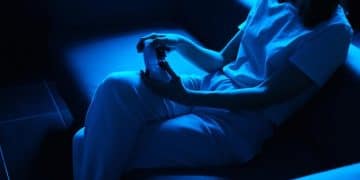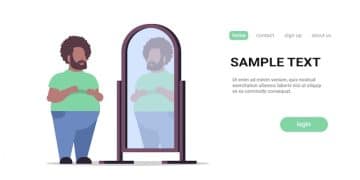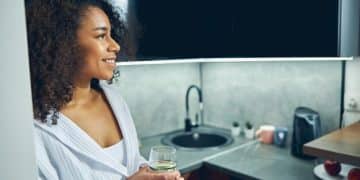Blue Light Truth: Protect Eyes & Improve Sleep by 35% in 2025
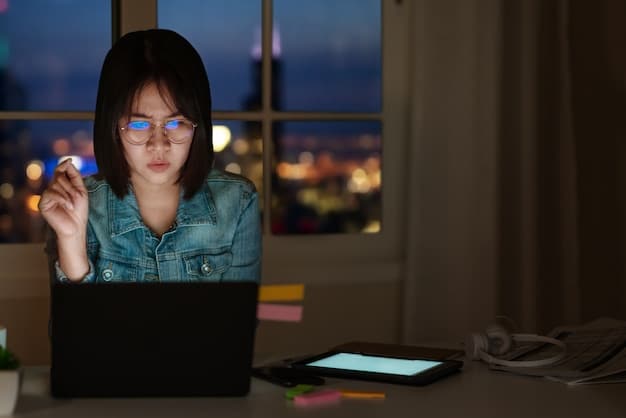
The Truth About Blue Light: How to Protect Your Eyes and Improve Sleep Quality by 35% in 2025 lies in understanding its effects on our circadian rhythm and employing strategies like blue light filters, screen time management, and optimizing sleep hygiene to mitigate its negative impacts and promote better overall health.
Are you tired of staring at screens all day only to toss and turn all night? The Truth About Blue Light: How to Protect Your Eyes and Improve Sleep Quality by 35% in 2025 is finally being revealed, and it’s time to understand how this pervasive light source impacts your health and what you can do about it.
Understanding Blue Light: What It Is and Where It Comes From
Blue light is a high-energy, short-wavelength light that’s part of the visible light spectrum. While it’s naturally present in sunlight, it’s also emitted by digital devices like smartphones, tablets, computers, and LED lighting. Understanding where blue light comes from is the first step in managing its impact on your health.
Natural vs. Artificial Blue Light
The sun is the primary source of blue light. However, our modern lifestyles have significantly increased our exposure to artificial blue light, mainly from screens and energy-efficient lighting.
Common Sources of Blue Light Exposure
Here’s a quick rundown of the most common sources of blue light exposure:
- Smartphones and Tablets
- Computer Monitors and Laptops
- LED Televisions
- Fluorescent and LED Lighting
Prolonged exposure to these artificial sources, especially in the evening, can disrupt our natural sleep-wake cycle.
In summary, blue light is all around us, but understanding its sources helps you make informed decisions about mitigating its effects.
The Effects of Blue Light on Your Eyes and Sleep
Blue light has a profound impact on both your eyes and sleep. While some exposure is beneficial during the day, excessive exposure, especially at night, can lead to various health issues. Recognizing these effects is crucial for taking preventive measures.

Digital Eye Strain: A Common Complaint
One of the most immediate effects of blue light is digital eye strain, also known as Computer Vision Syndrome. Symptoms include:
- Dry, irritated eyes
- Blurred vision
- Headaches
- Neck and shoulder pain
These symptoms can significantly impact your productivity and overall comfort.
Disrupting Your Sleep Cycle
Blue light interferes with the production of melatonin, a hormone that regulates sleep. By suppressing melatonin, blue light can make it harder to fall asleep and reduce the overall quality of your sleep.
Long-Term Health Implications
Research suggests that chronic blue light exposure may contribute to more serious health problems, including:
- Increased risk of age-related macular degeneration
- Potential links to certain types of cancer
- Contribution to metabolic disorders
Therefore, managing your blue light exposure is not just about immediate comfort but also about long-term health.
In essence, understanding the effects of blue light on your eyes and sleep is the first step in protecting your health and optimizing your well-being.
Blue Light and Melatonin: The Sleep Connection
Melatonin is a hormone produced by the pineal gland that plays a crucial role in regulating the sleep-wake cycle. Blue light has a significant impact on melatonin production, which in turn affects your sleep quality. Understanding this connection is key to improving your sleep.
How Blue Light Suppresses Melatonin
Blue light signals the brain to stay awake by suppressing the release of melatonin. This is beneficial during the day, helping you stay alert and focused. However, at night, this suppression can disrupt your natural sleep patterns.
The Impact on Sleep Quality
When melatonin production is suppressed, it can lead to:
- Difficulty falling asleep
- Reduced deep sleep
- Frequent awakenings during the night
- Daytime fatigue and reduced cognitive function
Strategies to Boost Melatonin Production
To counteract the effects of blue light on melatonin, consider the following strategies:
- Use blue light filters on your devices
- Avoid screen time at least 1-2 hours before bed
- Use red or amber lights in the evening
- Consider a melatonin supplement (after consulting with a healthcare professional)
Creating a Sleep-Friendly Environment
Optimizing your sleep environment can also help boost melatonin production. Make sure your bedroom is dark, quiet, and cool. Use blackout curtains, earplugs, and a comfortable mattress to create a sleep-friendly space.
In conclusion, understanding the connection between blue light and melatonin is essential for improving your sleep quality and overall health.
Practical Ways to Protect Your Eyes from Blue Light
Protecting your eyes from blue light is essential for maintaining good vision and preventing digital eye strain. There are several practical ways to reduce your exposure and mitigate its negative effects. Implementing these strategies can significantly improve your eye health and comfort.
Blue Light Blocking Glasses
Blue light blocking glasses are designed to filter out a significant portion of blue light emitted by screens. These glasses often have a slight yellow or amber tint.
Screen Filters and Apps
Screen filters and apps can adjust the color temperature of your screen, reducing the amount of blue light emitted. Many smartphones, tablets, and computers have built-in blue light filter settings.
Adjusting Screen Brightness and Contrast
Reducing the brightness and increasing the contrast of your screen can also help reduce eye strain. Experiment with different settings to find what’s most comfortable for your eyes.
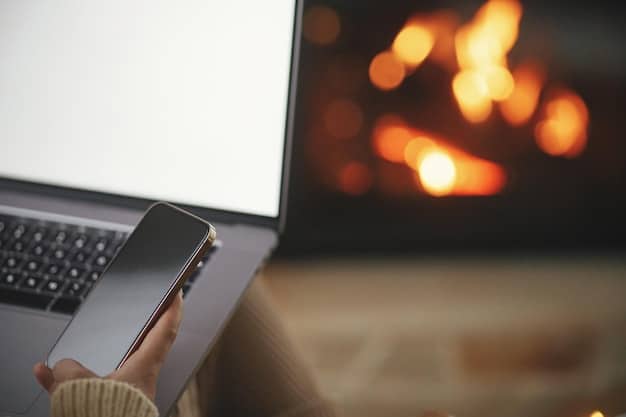
The 20-20-20 Rule
The 20-20-20 rule is a simple yet effective way to reduce eye strain. Every 20 minutes, look at something 20 feet away for 20 seconds. This gives your eyes a break and helps prevent fatigue.
Proper Lighting and Ergonomics
Ensure your workspace is well-lit and ergonomically optimized. Position your screen at arm’s length and slightly below eye level. Use a comfortable chair and take regular breaks to stretch and move around.
In summary, there are many practical ways to protect your eyes from blue light, from using specialized glasses to adjusting your screen settings and practicing good ergonomics.
Improving Sleep Quality: A Comprehensive Approach
Improving sleep quality involves more than just reducing blue light exposure. A comprehensive approach includes establishing good sleep hygiene practices, optimizing your sleep environment, and addressing any underlying health issues that may be affecting your sleep.
Establishing a Consistent Sleep Schedule
Going to bed and waking up at the same time every day, even on weekends, helps regulate your body’s natural sleep-wake cycle. This consistency can improve the quality and duration of your sleep.
Creating a Relaxing Bedtime Routine
A relaxing bedtime routine can help you wind down and prepare for sleep. This might include:
- Taking a warm bath or shower
- Reading a book (preferably a physical book, not an e-reader)
- Practicing relaxation techniques like deep breathing or meditation
- Listening to calming music
Optimizing Your Sleep Environment
Your sleep environment should be conducive to rest. Make sure your bedroom is:
- Dark
- Quiet
- Cool
- Comfortable
Limiting Caffeine and Alcohol Intake
Caffeine and alcohol can interfere with sleep. Avoid consuming these substances in the evening. Caffeine can keep you awake, while alcohol can disrupt your sleep cycle and lead to fragmented sleep.
In conclusion, improving sleep quality requires a comprehensive approach that includes minimizing blue light exposure, establishing good sleep hygiene practices, and optimizing your sleep environment.
The Future of Blue Light Protection: Innovations and Trends in 2025
As awareness of the effects of blue light grows, so does the innovation in blue light protection. By 2025, we can expect to see even more advanced and integrated solutions for mitigating blue light exposure and improving sleep quality. Staying informed about these trends can help you make the best choices for your health.
Advanced Blue Light Filtering Technologies
Future technologies will likely include more sophisticated blue light filters that can dynamically adjust to different lighting conditions and screen types. These filters may be integrated directly into devices or available as coatings for screens and lenses.
Smart Lighting Systems
Smart lighting systems will become more prevalent, automatically adjusting the color temperature and brightness of lights based on the time of day. These systems can reduce blue light exposure in the evening and promote better sleep.
Wearable Health Devices Integration
Wearable health devices, such as smartwatches and fitness trackers, will play a larger role in monitoring and managing blue light exposure. These devices can track your screen time, measure ambient light levels, and provide personalized recommendations for reducing blue light exposure.
Personalized Blue Light Solutions
As our understanding of individual responses to blue light grows, we can expect to see more personalized solutions tailored to specific needs and preferences. This might include custom-designed blue light blocking glasses, personalized screen settings, and tailored sleep recommendations.
In conclusion, the future of blue light protection looks promising, with increasingly advanced and integrated solutions that can help you protect your eyes, improve your sleep quality, and optimize your overall health.
| Key Point | Brief Description |
|---|---|
| 💡 Blue Light Sources | Screens and LEDs emit artificial blue light, affecting sleep. |
| 😴 Melatonin Impact | Blue light suppresses melatonin, disrupting sleep cycles. |
| 👓 Protection Methods | Use blue light glasses and screen filters to reduce exposure. |
| 🌙 Sleep Hygiene | Maintain a sleep schedule and optimize your sleep environment. |
FAQ
▼
Blue light is a high-energy portion of the visible light spectrum. It’s emitted by the sun and digital screens, impacting our alertness and sleep cycle due to its effect on melatonin production.
▼
Blue light suppresses the production of melatonin, a hormone that regulates sleep. Exposure in the evening can make it harder to fall asleep and reduce overall sleep quality.
▼
These are specially designed glasses that filter out a portion of the blue light emitted from screens, helping to reduce eye strain and improve sleep quality by allowing more melatonin production.
▼
Yes, screen filters can reduce the amount of blue light emitted from devices. Many smartphones and computers now have built-in settings for this, making it easier to minimize exposure.
▼
Alongside filters and glasses: reduce screen time before bed, ensure a dark/cool sleep environment, maintain a consistent sleep schedule, and practice the 20-20-20 rule during extended screen use.
Conclusion
Understanding the truth about blue light and implementing practical strategies to protect your eyes and improve sleep quality can significantly enhance your overall well-being. By embracing the latest innovations and trends, you can take control of your health and optimize your life in 2025 and beyond.
